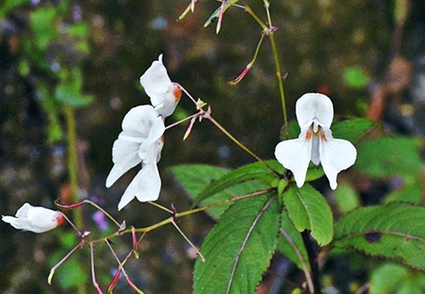Abstract
Impatiens violoides Edgew. ex Hook.f. (Balsaminaceae) is a little known steno-endemic spurless balsam species that was known only from a single type collection by Edgeworth in 1844. It is rediscovered after a gap of 179 years from its type locality in Shimla district, Himachal Pradesh, Western Himalaya. Augmented and detailed morphological description based on observations of living material is given along with global distribution; information on habitat and associated species, floral morphology photographs and IUCN red list assessment are also provided for the first time.
References
- Akiyama, S. (2021) Impatiens (Balsaminaceae) of Nepal (1) An Identification Key and Taxonomy of the Species of Sections Uniflorae, Fasciculatae and Axilliflorae. Bulletin of the National Museum of Nature and Science. Series B, Botany 47 (2): 79–101.
- Akiyama, S., Ohba, H. & Wakabayashi, M. (1991) Taxonomic notes of the east Himalayan species of Impatiens: studies of Himalayan Impatiens (Balsaminaceae). In: Ohba, H. & Malla, S.B. (Eds.) The Himalayan plants: volume 2. University Museum; University of Tokyo, Tokyo, pp. 67–94. https://doi.org/10.1111/j.1095-8339.1992.tb00270.x
- Basu, D. & Uniyal, B.P. (2002) Balsaminaceae. In: Singh, N.P., Singh, D.K. & Uniyal, B.P. (Eds.) Flora of Jammu & Kashmir, Vol. 1. Botanical Survey of India, Kolkata, pp. 772–781.
- Candolle, A.P. de (1830) Caprifoliaceae. In: Candolle, A.P. de (Ed.) Prodromus systematis naturalis regni vegetabilis, sive enumeratio contracta ordinum, generum, specierumque plantarum huc usque cognitarum, juxta methodi naturalis normas digesta. Vol. 4. Sumptibus Sociorum Treuttel et Würtz, Parisiis [Paris], p. 329.
- Chowdhery, H.J. & Wadhwa, B.M. (1984) Flora of Himachal Pradesh. Vols. 1–3. Botanical Survey of India, Calcutta, India, 860 pp.
- Don, D. (1837) Descriptions of Indian Gentianaceae. Transactions of the Linnean Society of London 17 (4): 529. https://doi.org/10.1111/j.1095-8339.1834.tb00041.x
- Don, G. (1830) Cedrus. In: Loudon, J.C. (Ed.) Hortus Britannicus. A catalogue of all the plants indigenous, cultivated in, or introduced to Britain. Printed for Longman, Rees, Orme, Brown and Green, London, p. 388.
- Edgeworth, M.P. (1846) Descriptions of some unpublished species of plants from North-Western India. Transactions of the Linnean Society of London 20 (1): 40. https://doi.org/10.1111/j.1096-3642.1846.tb00410.x
- Fischer, E. (2004) Balsaminaceae. In: Kubitzki, K. (Ed.) The Families and Genera of Vascular Plants VI. Springer, Berlin, pp. 20–25. https://doi.org/10.1007/978-3-662-07257-8_4
- Grey-Wilson, C. (1980) Impatiens of Africa: morphology; pollination and pollinators; ecology; phytogeography; hybridisation; keys and a systematic treatment of all African species; with a note on collecting and cultivation. Rotterdam; A.A. Balkema viii, 235 pp.
- Gross, H. (1913) Beiträge zur Kenntnis der Polygonaceen. Botanische Jahrbücher für Systematik, Pflanzengeschichte und Pflanzengeographie 49 (2): 277.
- Hara, H. (1972) New or noteworthy flowering plants from Eastern Himalaya (10). Journal of Japanese Botany 47 (5): 142.
- IUCN (2019) Guidelines for using the IUCN Red List categories and criteria, version 3.1, second edition. Available from: https://www.iucnredlist.org/ (accessed 5 November 2023)
- Hooker, J.D. & Thomson, T. (1859) Praecursores ad Floram Indicam. Journal of the proceedings of the Linnean Society. Botany 4: 136. https://doi.org/10.1111/j.1095-8339.1859.tb01160.x
- Hooker, J.D. (1904–1906) An epitome of the British Indian Species of Impatiens. Records of the Botanical Survey of India 4: 1–58.
- Janssens, S.B., Knox, E.B., Huysmans, S., Smets, E.F. & Merckx, V.S.T.F. (2009) Rapid radiation of Impatiens (Balsaminaceae) during Pliocene and Pleistocene: Result of a global climate change. Molecular Phylogenetics and Evolution 52 (3): 806–824. https://doi.org/10.1016/j.ympev.2009.04.013
- Karelin, G.S. & Kirilov, I.P. (1842) Enumeratio plantarum in desertis Songoriae orientalis et in jugo summarum alpium Alatau anno 1841 collectarum. Bulletin de la Société Imperiale des Naturalistes de Moscou 15 (2): 179.
- Khanna, K.K. (2001) Endemic plants of Uttar Pradesh (Angiosperms). Phytotaxonomy 1: 71–75.
- Lacaita, C.C. (1916) Plants collected in Sikkim, including the Kalimpong district, April 8th to May 9th, 1913. Journal of the Linnean Society. Botany. London 43: 467. https://doi.org/10.1111/j.1095-8339.1916.tb00614.x
- Planchon, J.E. (1887) Monographie des Ampélidées vraies. In: De Candolle, A.L.P.P. & C. De Candolle (Eds.), Monographiae phanerogamarum. Masson, Paris, 5(2): 451.
- Pusalkar, P.K. & Srivastava, S.K. (2018) Flora of Uttarakhand: Vol. 1: Gymnosperms and Angiosperms (Ranunculaceae—Moringaceae), Botanical Survey of India, Kolkata, pp. 869–870.
- Qin, F., Xue, T., Zhang, X., Yang, X., Yu, J., Gadagkar, S.R. & Yu, S. (2023) Past climate cooling and orogenesis of the Hengduan Mountains have influenced the evolution of Impatiens sect. Impatiens (Balsaminaceae) in the Northern Hemisphere. BMC Plant Biology 23 (1): 600. https://doi.org/10.1186/s12870-023-04625-w
- Rawat, D.S., Chandra, S. & Chaturvedi, P. (2022) Threatened flora of Uttarakhand: an update. Journal of Threatened Taxa 14 (12): 22309–22328. https://doi.org/10.11609/jott.6330.14.12.22309-22328
- Royle, J.F. (1836) Illustrations of the botany and other branches of the natural history of the Himalayan Mountains and of the flora of Cashmere 1(9). Allen, London, t. 86.
- Sharma, A., Singh, N. & Adamowski, W. (2019) Scully’s Balsam Impatiens scullyi Hook.f. (Balsaminaceae): a new record for India from Himachal Pradesh. Journal of Threatened Taxa 11 (8): 14065–14070. https://doi.org/10.11609/jott.4823.11.8.14065-14070
- Sherpa, N., Kasaju, S.K., Subedi, S. & Gogoi, R. (2021) Notes on the recollection and typification of Impatiens williamsii H.Hara (Balsaminaceae)—A little known endemic species of Nepal. Nelumbo 63 (2): 23–27. https://doi.org/10.20324/nelumbo/v63/2021/167712
- Singh, H., Sharma, A. & Adamowski, W. (2022) Impatiens glauca Hook. f. et Thomson—A little known Himalayan species with augmented description and a new spurless variety. Phytotaxa 539 (3): 280–286. https://doi.org/10.11646/phytotaxa.539.3.7
- Vivekananthan, K., Rathakrishnan, N.C., Swaminathan, M.S. & Ghara, L.K. (1997) Balsaminaceae. In: Hajra P.K., Nair, V.J. & Daniel, P. (Eds.) Flora of India (Maphighiaceae—Dichapetalaceae), 4. Botanical Survey of India, Calcutta, pp. 95–229.
- Wallich, N. (1824) Impatiens. In: Carey, W. & Wallich, N. (Eds.) Flora Indica; or Descriptions of Indian Plants, by the Late William Roxburgh, Vol. 2. Mission Press, Serampore, p. 458.
- Yu, S.X., Janssens, S.B., Zhu, X.Y., Liden, M., Gao, T.G. & Wang, W. (2016) Phylogeny of Impatiens (Balsaminaceae):integrating molecular and morphological evidence into a new classification. Cladistics 32: 179–197. https://doi.org/10.1111/cla.12119
- Efloraofindia (2023) Available from: https://efloraofindia.com/2014/10/30/impatiens-violoides/ (accessed 5 November 2023)


